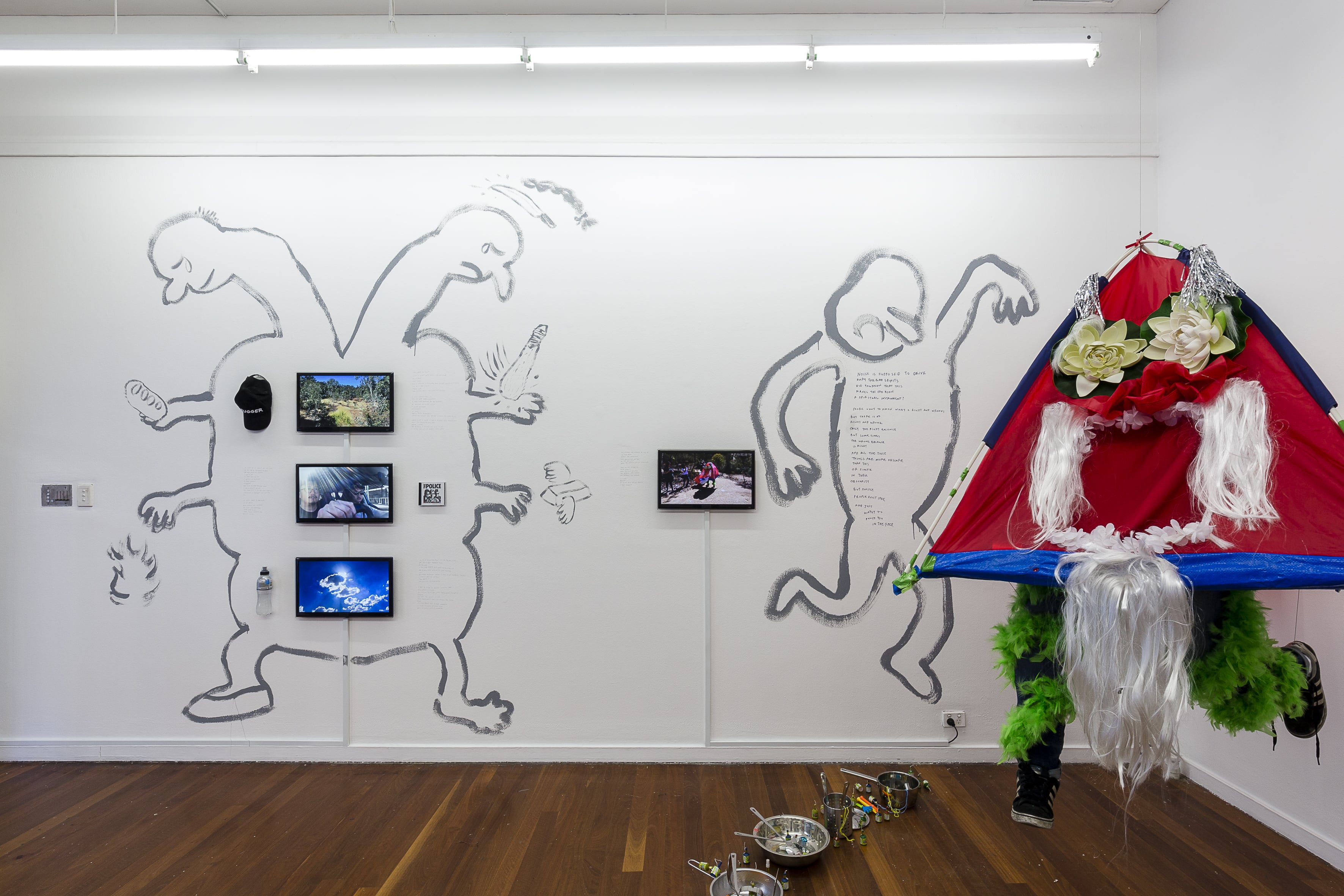


Artists: Jason Phu and John Young Zerunge
Historian: Karen Schamberger
Curators: Micheal Do and Mikala Tai
A historian, two curators, and two artists travel to Young, NSW. This is not the set-up for a bad joke, but the culmination of an exhibition more than ten years in the making.
The Burrangong Affray at 4A Centre for Contemporary Art is an ambitious exhibition based on a ‘little-known’ (or rather, under-known) historical event – the anti-Chinese riots that took place in the gold mining town of Lambing Flat near Burrangong (present day Young, NSW) between 1860 – 1861. Tensions between Chinese and European miners had grown increasingly precarious, what had started as anti-Chinese sentiments due to cultural and social difference quickly escalated to violence. In what became known as the ‘Lambing Flat Riots’, thousands of European, North American and Australian-born miners threatened, robbed, beat up, and scalped Chinese miners, and burnt down their campsites. As horrific as the events of the riots were, they would come to play a formative role in public opinion and the passing of discriminatory migratory laws by the state and federal governments, effectively leading to what became known the ‘White Australia Policy’ forty years later.
Faced with the almost insurmountable task of responding to this dark spectre of history, artists Jason Phu and John Young have created brave and compelling works that examine this historical flash point from a contemporary perspective. The Burrangong Affray focuses on both the lead-up to and repercussions of these riots, and also sheds light on the unsettling parallels with our current political discourse and discussions of migration.
The choice to pair Jason Phu and John Young together for this exhibition is a bold but effective one. Phu is an early-career artist known for his irreverent and experimental style; interested in language and storytelling, Phu’s practice often blends family narratives with highly personal, candid and at times humorous works. John Young, on the other hand, is a well-established painter and one of the pivotal figures in establishing the Asian Australian Artist’s Association – now 4A – and currently sits on the organisation’s board.
On the ground floor of the gallery, Phu has created a multimedia installation encompassing video, sculpture, text and drawing. Documenting the physical road trip to Young with his fellow artist and curators, as well as the landscape of the surrounds, Phu invites audiences to imagine the lived experience of the Chinese miners from an untold perspective. Through a series of wall writings and drawings, Phu interweaves the stories of miners with anecdotes and experiences from his own family narrative, forging a clear connection between Phu’s contemporary experiences of discrimination and those of the miners.
One of the most affecting works by Phu commemorates the role of James Roberts, who provided shelter and protection for the miners at his farm on Currawong Creek, after their camps were destroyed. Phu visited the site of Robert’s farm and burnt a piece of plaited rope spelling out the word ‘queue’ on the grasslands. The act of burning makes visual reference to the riots, while the rope itself is suggestive of the braided hairstyles of the Chinese miners. Against a dark backdrop, the flaming words appear like ghosts or spirits, haunting us from the past. But it is not just the spectre of the past that haunts us, it is also the reality of a present where ‘queues’ evoke images of immigration, or otherwise bureaucratic ways to order and delineate people.
Upstairs at 4A, John Young has also responded to the locality and site of the riots with a thoughtful body of work. Known predominantly as a painter, Young has made his first ever performance and video work for the exhibition. Titled The Field (2018), the video work pieces together an assemblage of images and motifs underscored with a striking sound score. One particular section also evokes the visual motif of the Chinese miners’ braid, this time on the head of a young female. A hand to the right of the screen tugs and pulls at the hair, the pain and tension visible in her face. The choice of a female subject is an interesting one, as traditionally the braids were a hairstyle reserved strictly for Chinese men. I wonder about the place of Chinese women in these narratives – where are the wives and daughters of the miners?
In addition to The Field, Young has included a suite of 27 prints that intermingle historical archives, documents and dates to try to make sense of the events of 1860 - 1861. Installed salon-style on the gallery wall, the series provokes a complex reading of multiple narratives and conflicting accounts, much like how history itself is told through multiple perspectives. Their starkness is offset by the inclusion of four scrolls by Phu on the adjoining wall, which playfully reverse the antagonism of the riot slogan ‘Roll up, roll up, no Chinese’, with alternate slogans and pictures.
The Burrangong Affray does not seek to evoke sympathy or empathy from audience members; rather, it makes clear that as contemporary viewers we are not unburdened by Australia’s difficult past. The exhibition challenges the way in which histories are told, or untold, through particular accepted narratives. Perhaps the reach of the curatorial premise was such that any Chinese-Australian artist could have been invited to make works in response. After all, this is really an exhibition that examines the legacy of Chinese migration in colonial Australia, and how present day cultural understanding and awareness has been shaped by these events. The effectiveness of The Burrangong Affray results from the way that Phu and Young’s individual works respond to and reflect each other. While the basis of the exhibition was a decade of research based on archival materials and documentation, Phu and Young’s works give the research form by linking it to a much more personally-invested interpretation.
Sophia Cai is a Melbourne-based early-career curator and arts writer with a particular interest in Asian art history as well as contemporary craft.
